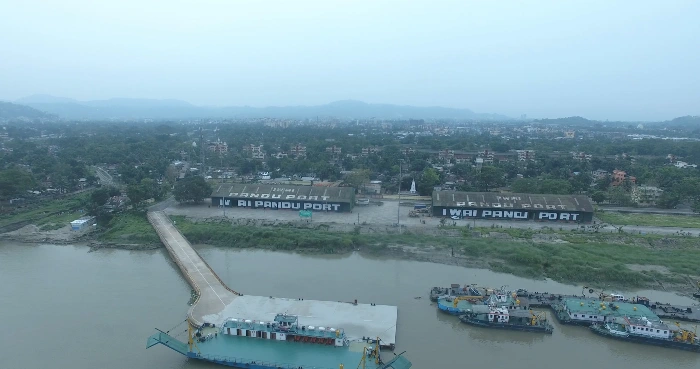
Pandu Port development gets new significance after a long delay of 25 years
KOLKATA : Prime Minister Shri Narendra Modi unveiled several initiatives on Friday 13 January, related to the country’s inland waterways, of which the most high profile was the launch of world’s longest river cruise from Varanasi to Dibrugarh carrying guests from overseas. While the river cruise is symbolic in nature as the country holds the G20 presidency for 2023, the foundation laying for a ship repair facility at Pandu Inland Waterway Port in Guwahati, which was in the process of delaying for years, holds more significance.
The new ship repair facility will be in addition to the one located in Kolkata. Currently vessels and barges operating in the riverways of northeast India have to avail the services of the ship repair facility in Kolkata, entailing longer voyage time and high cost.
“The proposal for developing the ship repair facility at Guwahati is a very old one. Stated in 1997 onwards with the sanction of the estimate under centrally sponsored scheme by the Ministry of Shipping & Port submitted by IWT (Inland Waterway Transport) Directorate, Government of Assam,” said Subhakar Dandapat, former Hydrographic Chief, Project Director and Chief Engineer (Marine & Project) at Inland Waterways Authority of India.
“The contract was awarded to a Mumbai based company who after some time left it without completing, perhaps because of some technical issues. It was revived in 2012-13 by IWAI (Inland Waterways Authority of India). A fresh estimate was sanctioned under NEC (North Eastern Council) fund and a fresh contract for developing the ship repairing facilities with slipway on the inclined path awarded to a Mangalore-based company. Then also, it could not be completed,” he added.
With focus on multimodal transport development in the country, the government in the past few years has been pushing for the development of inland waterways, especially National Waterway 1 (Ganga) and National Waterway 2 (Brahmaputra). Of these two, National Waterway 2 holds the most potential as it connects the riverine networks between northeast region, West Bengal and Bangladesh.
India’s focus on enhancing the regional connectivity between Bangladesh, Bhutan, India, Nepal or BBIN nations has also increased the potential for such riverine ports in the region. Inland Waterways Authority of India aims to transform Pandu facility into an EXIM port and steps are being taken for achieving the same.
Efforts are underway for transport of coal from the northeast region via the Pandu port to Bangladesh. Further downstream, Dhubri port located near the Indo-Bangladesh border, has become a transit hub for transport of commodities between Bhutan and Bangladesh such as stone chips.
Renewed focus was given to the development of Pandu port when Shri Sarbananda Sonowal, former Chief Minister of Assam, was appointed as the Union Minister for Ports, Shipping and Waterways in July 2021. The decision to go ahead with the development of the ship repair facility was made the following month on August 26, 2021. The port is being developed at a cost of Rs. 73 crore.
“A fresh study was conducted through IIT (Indian Institute of Technology), Chennai and for developing it, an agreement was signed between IWAI and Cochin Shipyard Ltd, Kochi. Now after changing the layout for lifting the vessels to the shore/ bank for undertaking the bottom hull out of the water with other repair works, the facilities will be developed,” said Dandapat.
According to operators engaged in the transport of commodities via inland waterways, the Pandu port will also be equipped for undertaking electronic customs clearance for commodities, cargoes.
The development of the port will include both landside and water development with phase I comprising development of boat hoist jetty, transfer bay and repair bay.
The landside development will be further enhanced by the construction of a dedicated elevated road connecting the Pandu port to National Highways 27 for streamlined transport of cargo.
The existing road connectivity to the port faces constraints as it passes through the populated city area and a dedicated elevated road will address the congestion problems.
In pre-independent India, there was active riverway linkage between Bengal and northeast India. Tea and jute were transported via Brahmaputra up to Kolkata and in 1847 the British India Steam Navigation Company introduced steamships on these routes. But post partition of the subcontinent, these waterways remained unutilised for many decades.
The development of a ship repair facility at Pandu, increased push for transport of cargo via Brahmaputra and IBP route are one of the many steps needed to reinvigorate a legacy transport network which promoted commerce and trade in the 19th and early part of 20th century in the region.
